When Terri-Lynn Williams-Davidson and Robert Davidson celebrated their wedding with a traditional ceremony, it was the first in over a century to be performed under Haida law. Their recent book, A Haida Wedding, provides an intimate photographic window into that day, marking the resurgence of a tradition that was nearly lost to colonial forces. This excerpt focuses on the canoe procession of Robert’s clan to Terri-Lynn’s village.
In the spring of 1996, we decided that we would be married in a traditional Haida wedding ceremony. Such ceremonies had not occurred in the living memory of the Elders and we wanted to draw upon our cultural teachings and honour Haida ceremonies and laws.
Terri-Lynn grew up in the southern village of HlGaagilda Llnagaay (Skidegate), and Robert grew up in the northern village of Gad Gaywáas (Old Massett, also known as Gaauu). Traditionally, Haida weddings were held in the bride’s family home, in her father’s town. We agreed that our wedding would be held in HlGaagilda Llnagaay (Skidegate).
Our wedding invitation announced that the day would begin with a ceremonial canoe arrival. This is because we needed a way for Robert and his clan to arrive into Skidegate. In historic times, guests from other towns would have travelled in canoes. Reg Davidson, Robert’s brother, suggested that there be a traditional canoe arrival.
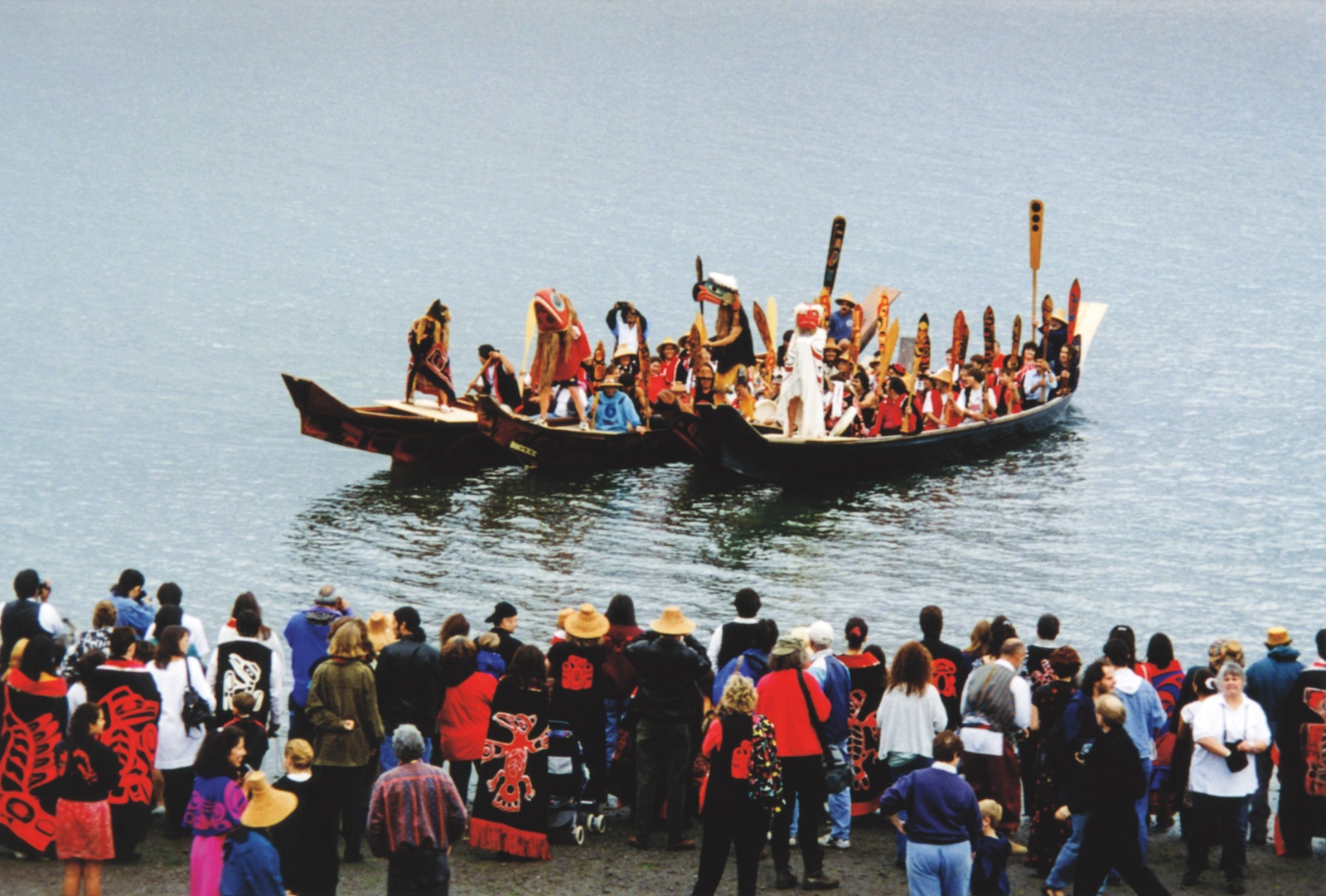
The Haida and other Indigenous Peoples of the Northwest Coast ingeniously transformed, carved, and steamed large, old-growth cedar trees into canoes throughout history. We agreed that a canoe arrival would be fitting as it would respect and integrate the spiritual energy of the interconnected land and sea.
The Haida and other Indigenous Peoples of the Northwest Coast ingeniously transformed, carved, and steamed large, old-growth cedar trees into canoes throughout history. Traditionally, canoes allowed the Haida to gather deep sea fish such as halibut and sablefish. Canoes provided a way to travel between the ocean and land realms and facilitated access to knowledge from the Ocean Peoples (the beings of the ocean realm). We agreed that a canoe arrival would be fitting as it would respect and integrate the spiritual energy of the interconnected land and sea.
We planned for the canoes to arrive at “half-tide” in Skidegate. The invitation only gave that as the start time because we loved the idea of guests being attentive to the cycles of the ocean. Reg provided his canoe and we rented three other canoes for the ceremony: Bill Reid’s Loo Taas (Wave Eater), the Loo Plex (a replica of the Loo Taas made of fibreglass), and Christian White’s canoe.
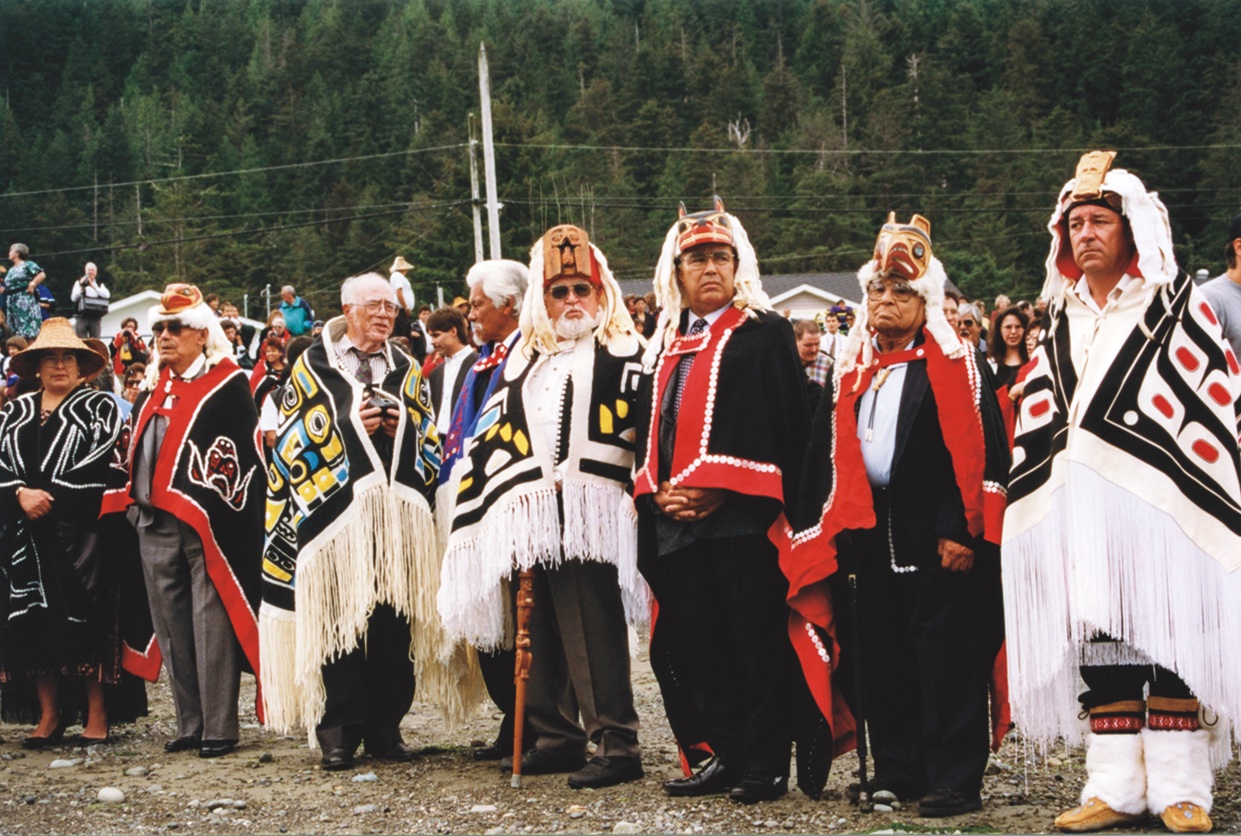
When guests approach a village, they must always seek permission to land from the village’s Hereditary Chief. The Hereditary Chiefs attending that day stood together for the welcome of Robert and the Ts’aa.ahl ‘Laanas Clan. Left to right: Chief Gidkun, Nathan Young, and Percy Williams (representing Niis Wes, Chief Skedans, Ernie Wilson).
We wanted to maintain the focus on the marriage ceremony, rather than a multi-day canoe journey from Massett. The Ts’aa.ahl ‘Laanaas had also lived at Kay ‘Llnagaay (Sea Lion Town, also known as Second Beach). Robert and Reg thought it would be fitting for the canoes to leave from there, instead of from Massett.
“The start of paddling my party by canoe from Gad Gaywáas (Old Massett) was organized by Skil K‘aatla.as, my brother Reg,” said Robert. “There were four canoes with platforms on the bow of each one for the dancers. One canoe for díi skáanalang (my aunties, women of my father’s clan), who have been a great support on my many functions as well as clan functions. Another canoe carried the Ts’aa.ahl ‘Laanas Clan, including myself. The other two canoes carried supporters from other Eagle Clans.”
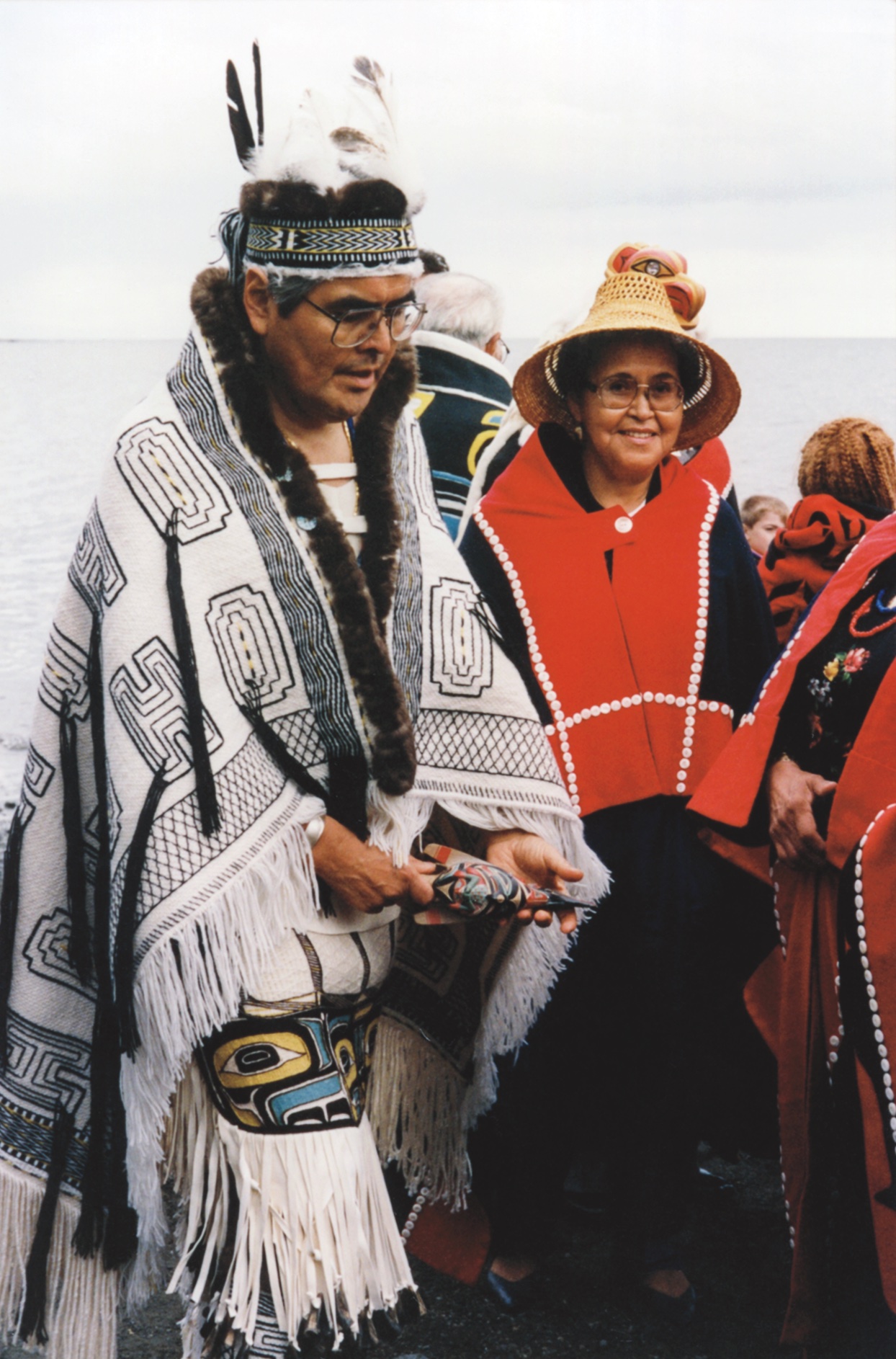
Robert, on the shoreline with Aunty Merle Anderson. He holds a Raven rattle by Bill Holm, which he carried with him for the welcome ceremonies.
“Terri-Lynn did everything, all the research. I just helped them (Robert and Terri-Lynn) organize the canoes,” said Reg. “I was inspired by the old film of the Kwakwaka‘wakw (Edward Curtis’s 1914 film, In the Land of the War Canoes), so I tried to do the same thing. I made plywood platforms for the dancers to perform on, inside the bows of the canoes. So many people came and wanted to be part of it.”
Second Beach has a sloped area suitable for launching canoes and the Loo Taas and Loo Plex were both located there. It was a beautiful place for Robert’s family to gather that morning, and people parked along the road to Skidegate to see the flotilla of canoes leave.
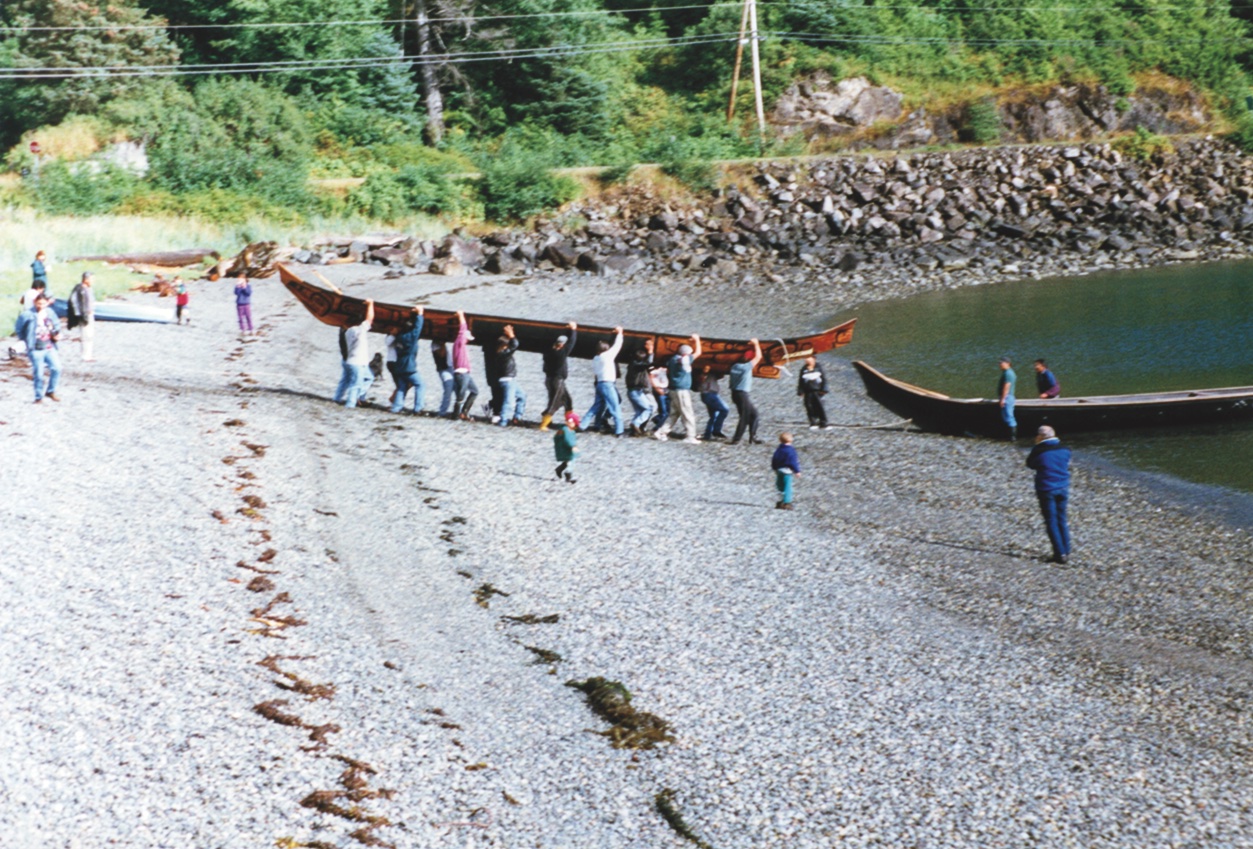
Carrying the Loo Taas to the ocean, to join the Loo Plex in the water.
The canoes made their way from Second Beach to the Skidegate waterfront. The excitement in the community was palpable, and hundreds gathered in Skidegate. Robert wore an apron woven in the naaxiin | náaxiin (Chilkat) tradition, which he had purchased in the 1980s from master weaver Cheryl Samuel.
Terri-Lynn’s cousins Guujaaw (as he was known then; he is now Hereditary Chief Gidansda) and Tyler Crosby sang onshore as guests assembled on the beach. They sang canoe songs that our great-grandmother, Gid7ahl-Gudsllaay, Susan Williams, often sang. Robert sang for the dancers on the prow-platforms as the canoes approached Skidegate. The paddlers frequently raised their paddles and tapped the handles on the gunnel of the canoe, making an incredible noise and adding to the drama.
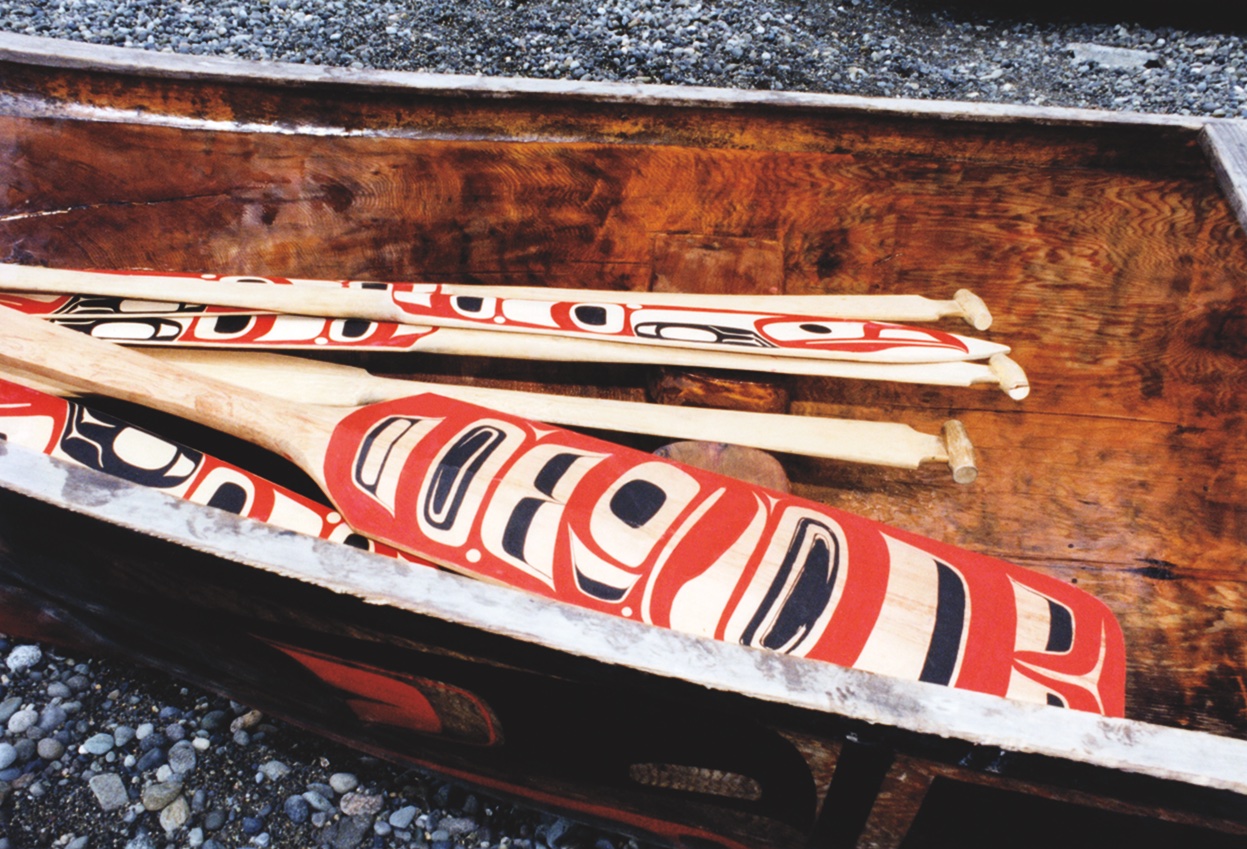
The interior of Reg’s canoe containing paddles painted with Reg’s designs. The large steering paddle is in the foreground.
When guests approach a village, they must always seek permission to land from the village’s Hereditary Chief. The Hereditary Chiefs attending that day stood together for the welcome of Robert and the Ts’aa.ahl ‘Laanas Clan.
“We were honoured that the Hereditary Chiefs who were in Haida Gwaii at the time joined Chief Skidegate to welcome the canoes,” said Terri-Lynn. “Unfortunately, my Aunty Peggy Wilson passed away the week before our wedding. Her husband was my mother’s brother, Niis Wes, Ernie Wilson, and the Chief of our Clan, the Gagyals K‘iiGawaay (Skedans Ravens). He left Haida Gwaii to bring her home to her family in the Nisga’a Nation. We asked the family if we might proceed with our wedding and were so grateful that they gave their permission. My cousin (older than I am, so I knew him as an uncle), Percy Williams, represented Chief Niis Wes at our Gud iina Gihl Ceremony, for he was to become Chief Gidansda after Uncle Ernie. Illjuuwaas, Reynold Russ, the Hereditary Chief of Masset, also could not attend, but May Russ attended as his representative.”
“When we arrived on the beach of Skidegate, Chief Skidegate and many other Chiefs were waiting our arrival,” said Robert. “The Elder of my Clan, Guusaaw Jang7waas, Dean Edgars, asked for permission to land. Without hesitation Chief Skidegate welcomed us. Guusaaw Jang7waas later admitted that his worry was, ‘What if they don’t allow us to land?’”
There are many Haida songs, for many different occasions, including songs for canoe journeys for the arrival and welcome of canoes, and for spreading the fine down feathers of eagles in a headdress dance to symbolize peace. Often, headdress dances are owned by Hereditary Chiefs. Such songs, dances, and ceremonies contain and enact laws and Haida ways of being.
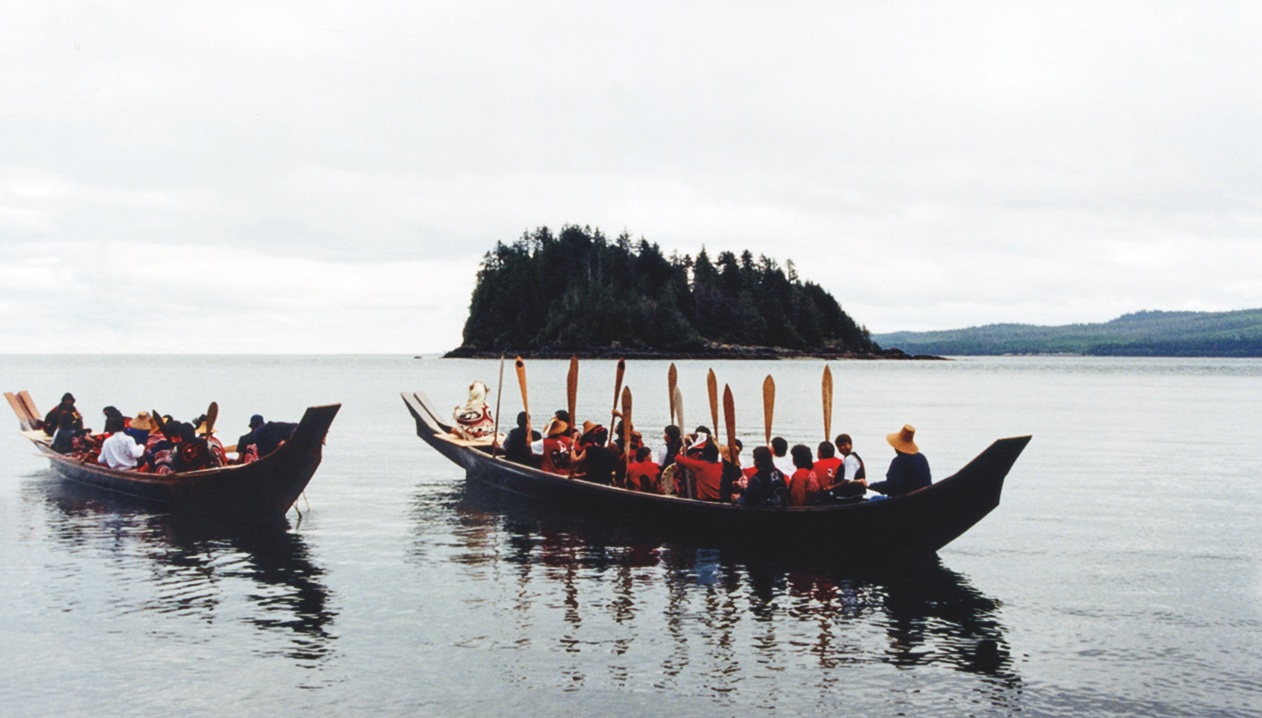
The Loo Taas and Loo Plex start the journey. Skilay, Ernie Collison, is steering the Loo Plex. He is wearing a hat that Robert gifted to him; it was one of the first spruce root hats that Robert purchased from Skilay’s grandmother, Emily Thompson.
As guests arriving at Skidegate, those on the canoes needed to convey peaceful intentions. Robert sang a headdress song that his late grandfather Robert Davidson sang and which he learned from his nanaay | naanii, Florence Davidson. Reg danced, spreading the eagle down.
The members of Terri-Lynn’s Clan, the Gagyals K‘iiGawaay, stood with the Hereditary Chiefs to greet the Ts’aa.ahl ‘Laanas. Guujaaw (now Hereditary Chief Gidansda) sang Chief Skidegate’s welcome song and her late brother, T’aawgaanyaad, Godfrey (Didi) Williams, joined by her cousins, Conrad Collinson, and Kelly Jones, danced the Chief Skidegate headdress song—as they had many times in their youth as part of the Skidegate Haida Dancers.
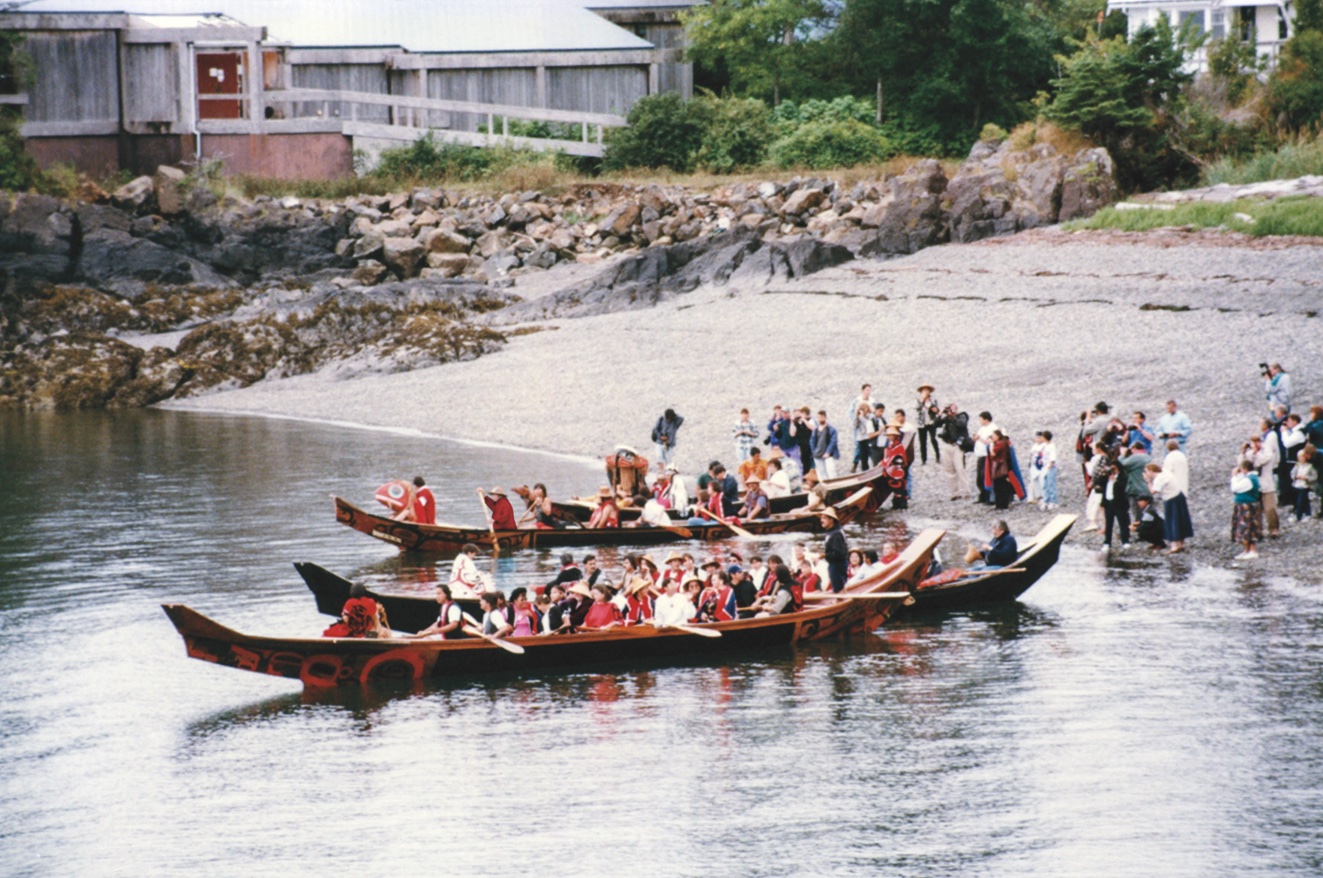
The four canoes leaving Second Beach.
After the ceremonial welcome, Robert was the first to go ashore.
“They picked him (Robert) up from the canoe and carried him to shore,” said Ilsk’yalas, Delores Churchill. “I was so scared they would drop him with the robe on!”
Once permitted to land, and after everyone had come ashore, the canoes were carried up above the tideline for safe keeping for the night.
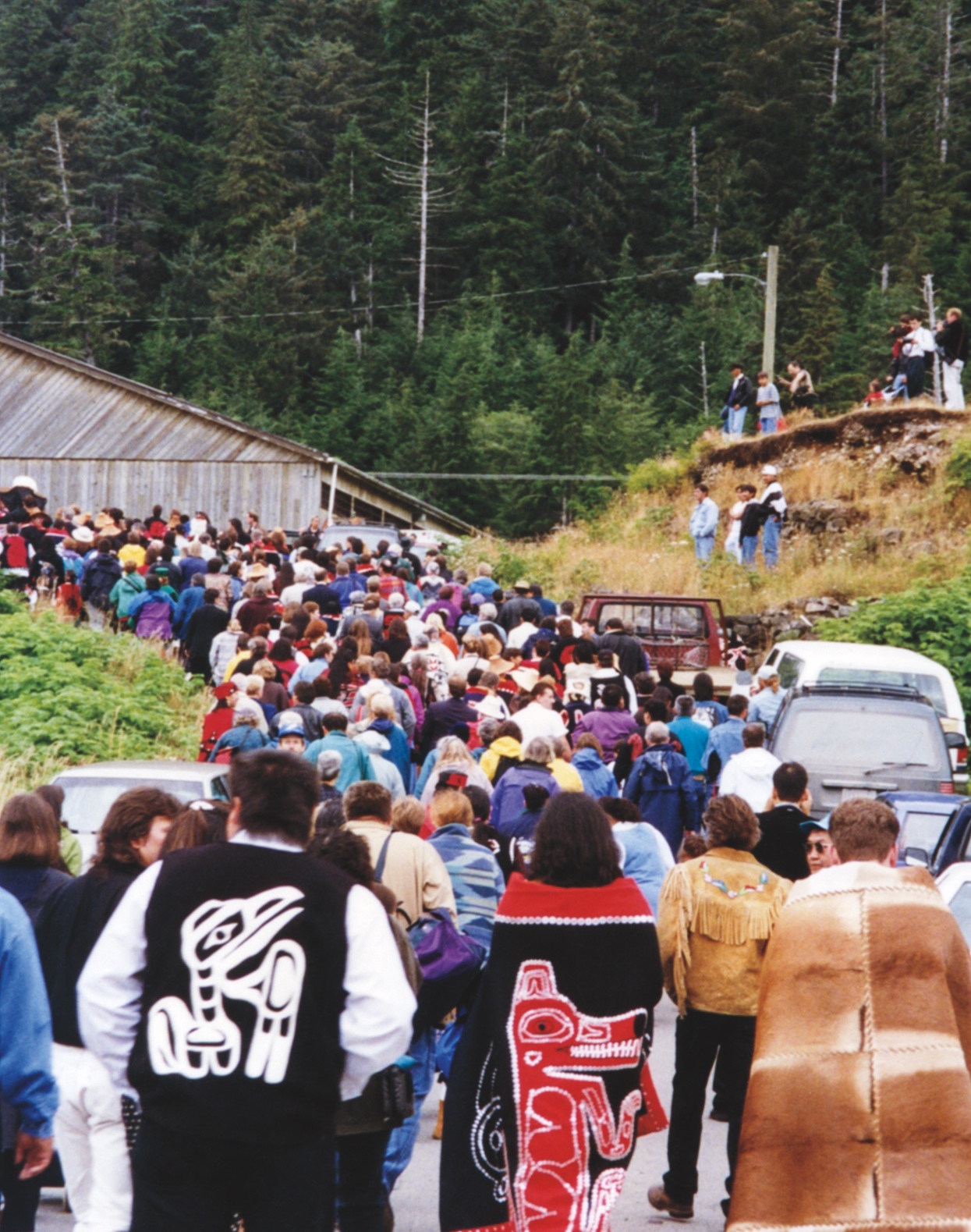
The guests making their way to the Wedding Feast, many wearing traditional clothing as encouraged in the invitation.
“After unloading the canoes that carried dii sKáan-Galang (my paternal aunties), Ts’aa.ahl ‘Laanas, and other Eagle Clan members, we were escorted up the community hall led by the Chiefs,” said Robert. “Dii sKáan-Galang escorted me up to the hall.”
Excerpted from A Haida Wedding by Terri-Lynn Williams-Davidson with Robert Davidson. © 2023. Published by Heritage House. All rights reserved. Photos courtesy of Terri-Lynn Williams-Davidson and Robert Davidson. Read more stories about community.









